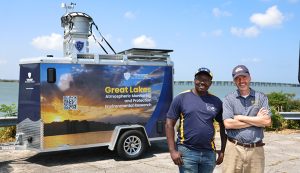A multidisciplinary team from The University of Toledo is launching a new investigation into how extreme weather and changing soil conditions may influence the release and spread of airborne algal toxins along the shores of Lake Erie.
The project, which is backed by a $300,000 grant from the National Science Foundation, aims to fill critical gaps in our knowledge about harmful algal blooms and potentially provide new mitigation strategies to blunt their impact.

Dr. Kennedy Doro, left, an associate professor in the Department of Environmental Sciences, and Dr. David Kennedy, a professor of medicine, will analyze water, air and soil in and around Lake Erie to understand how changing soil conditions may influence the release and spread of airborne algal toxins.
“Harmful algal blooms are a complex issue that threaten not only the health of our lake, but also our own health,” said Dr. Kennedy Doro, an associate professor in the Department of Environmental Sciences and the project’s lead investigator. “By linking geosciences and health sciences, we hope to answer some really important questions about harmful algal blooms that we could not answer on our own. It’s the height of innovative research.”
Fueled by nutrient pollution and aided by Lake Erie’s shallow and easily warmed water, long-lasting blooms of blue-green algae have become a frequent occurrence. Not only do the blooms cover the lake’s surface with foul-smelling, thick green sludge, but they also produce a mix of dangerous toxins, including one of the most concerning called microcystin.
As waves crash against the shoreline and spray is kicked up by speeding watercraft, the toxins can become airborne. UToledo scientists are already in the midst of a multiyear study looking at how exposure to those aerosolized toxins impacts the health of people who spend significant time near Lake Erie.
In the new NSF-funded project, UToledo researchers are turning their attention to how weather-driven changes in soil chemistry may influence how much microcystin is released by a given bloom and how easily it becomes airborne.
Alongside Doro, the multidisciplinary team includes Dr. David Kennedy, a professor of medicine, and Dr. Steven Haller and Dr. Andrew Fribley, both associate professors in the Department of Medicine. Together, they bring complementary expertise in environmental science, toxicology, and biomedical research, enabling a comprehensive approach to understanding how environmental stressors may alter the airborne transmission of harmful algal bloom toxins.
“There are hundreds of different flavors of microcystin, but some are better than others at becoming airborne,” Kennedy said. “We want to know why that is and have a better understanding of the conditions that make it easier for toxins in the lake to be released into the air.”
Kennedy and Doro think a big part of that answer comes from the soils around Lake Erie — and how they’re being affected by prolonged droughts, heavy rain and seiches, which occur when strong winds temporarily push water from one side of the lake to the other.
Those events can all alter soil oxygen levels and soil chemistry, potentially changing how the soil stores and releases nutrients.
“Essentially, we’re asking the question of whether stressed soils can enhance the release of microcystin that humans could be exposed to,” Doro said. “This is the first time we’re directly studying this issue, and it could help us develop new strategies to protect the lake ecosystem and human health.”
The study calls for UToledo scientists to analyze water, air and soil in and around the lake. To do that, they will deploy a network of soil sensors and air samplers, including those on the University’s “GLAMPER,” an innovative trailer-mounted atmospheric sampling platform.
Their findings could help inform new interventions to improve water quality and reduce threats to human health as well as guiding improved forecasting models for algal bloom toxicity.
“Over the last decade, we have developed a much more sophisticated understanding of the external factors that impact how toxic an individual bloom is and how the toxins get released,” Kennedy said. “This is another piece of that puzzle. Ideally, we’re not dealing with harmful algal blooms, but in the meantime it’s important we have the tools and knowledge to limit their effects.”